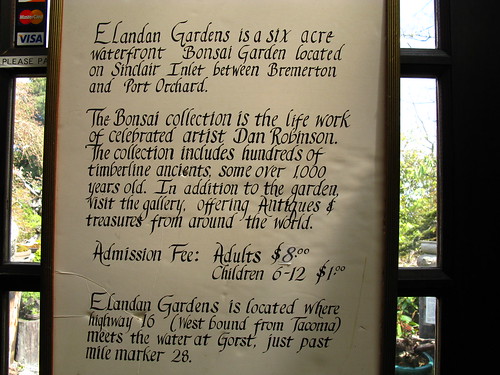
Last Friday, my friend Julie took me to visit Elandan Gardens, a former dump-site on the waterfront across the Puget Sound west of Seattle. Elandan has a most incredible collection of bonsai and dwarfed plants.
I am not a bonsai aficionado, but I feel inspired to become one after visiting Elandan. Hundreds of specimens line a path along the edge of a small promontory, further adorned with large pieces of driftwood, interesting rocks, upturned old tree roots, and, of course, waterfront views. The garden is one part of a family-owned and operated home-and-garden design company. Just visiting the design store accompanying the garden is with worth the price of a ferry ride to Bremerton, imo.
But we came to see the gardens, of course.
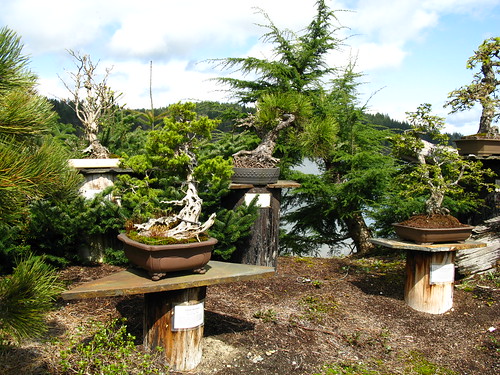
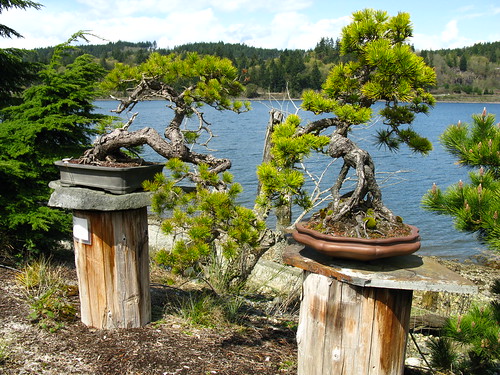
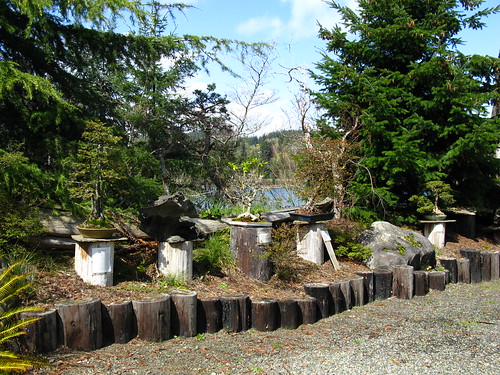
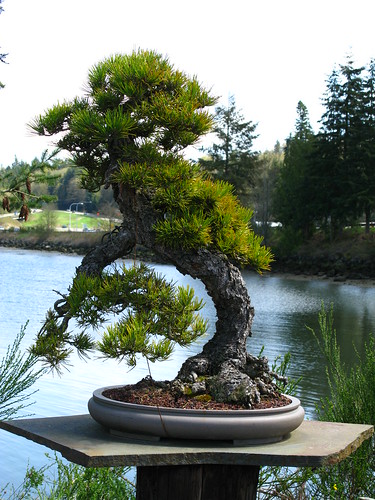
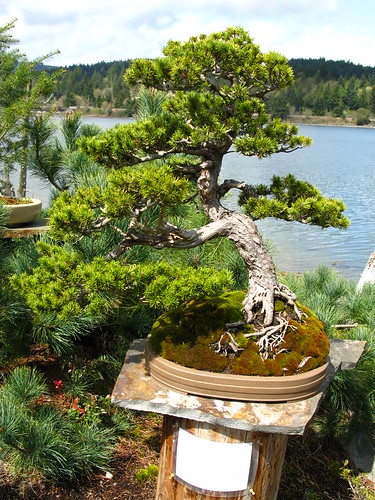
Coast redwood (Sequoia sempervirens):
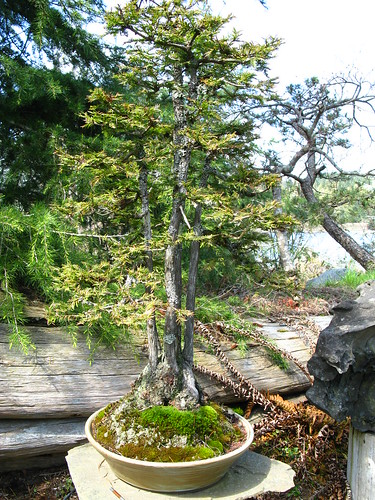
Atlas Cedar (Cedrus atlantica):
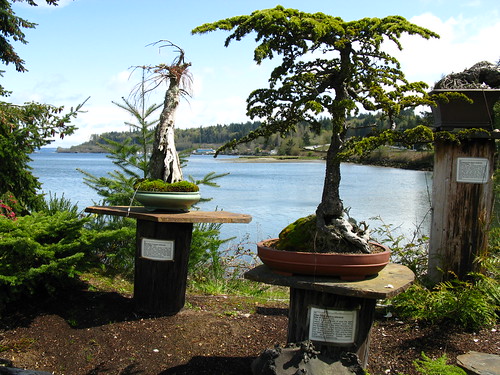
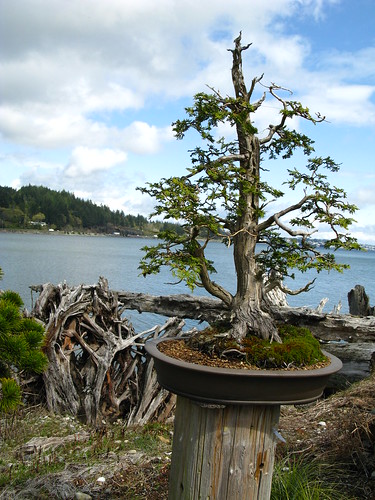
This was one of my favorite specimens, a climbing hydrangea (Hydrangea petiolaris) trained into a loop. I'm afraid it didn't photograph especially well.
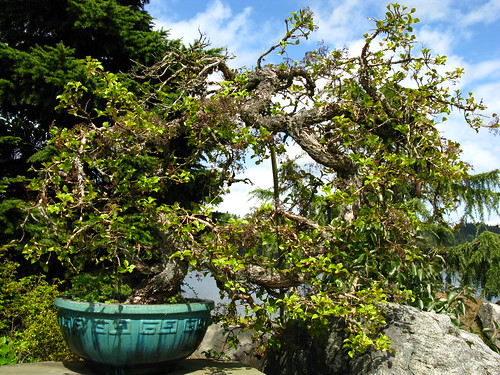
Curatorial information dated the plant to 1895.
“This splendid lace cap was salvaged from an old residence that was scheduled to be demolished. Peeling its clinging branches off the old wooden wall was tricky. Eminently reducible in size, I decided to leave it big and beautiful. The wood is not very strong, when the wind blows, the tree wobbles a bit freely.”It was just leafing out, and about to flower.
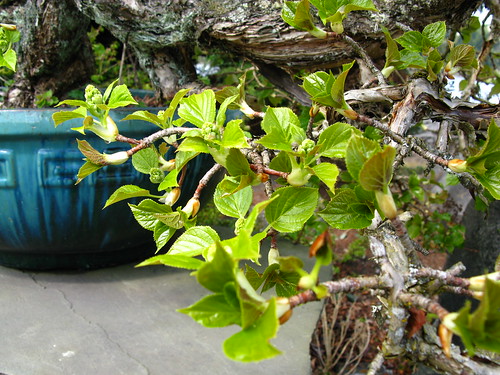
Many other specimens were collected as dwarfs found in the wild, and converted to bonsai. Elandan founder Dan Robinson dated his Rocky Mountain Juniper (Juniperus scopularum) collected in Montana to 1250 A.D.

"Discovered near Drummond on a quick reconnoiter up a hill in 1989. Carrying just a crowbar and pruners, I had to sacrifice my shirt to tie up the roots of this beauty after extraction. It was growing in crumbling basalt, so it came out bare root. Its incredible trunk line and profound age make it a favorite."(I'll just assume all the wild collecting was done on the up and up.)
This shore pine (Pinus contorta contorta), dated to 1500 AD, is a work in progress.
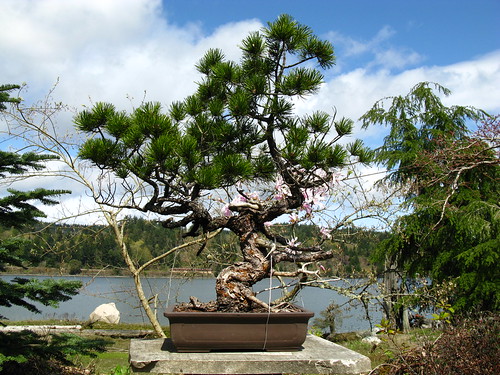
"This splendid old pine was collected from a boggy site in the northern end of Vancouver Island in 2003. Nearly eight inches of accreted overburden buried its basal character. Healthy and ready for training, its left-hand branch will be lowered about six inches thereby eliminating its two top look.”Many other plants, like this crinkly leaf maple (Acer palmatum crispum) were given or sold to Elandan by other bonsai enthusiasts, or acquired through trade.
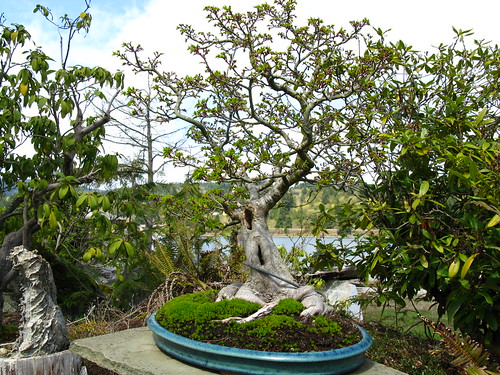
"Gifted to Elandan Gardens in 1990, this treasure of a tree had never received Bonsai training. Mary Davis had given it the ball-type pruning just to keep it small. Its conversion to bonsai involved the removal of several large limbs, the scars of which are still evident. The hole in the trunk was an extra incision designed to interrupt the flawless lower trunk with a bit of aging.”

The curatorial notes throughout the garden provided some fascinating plant-biographical information. This Japanese Larch (Laryx laptoleptis) entered the world in 1973.
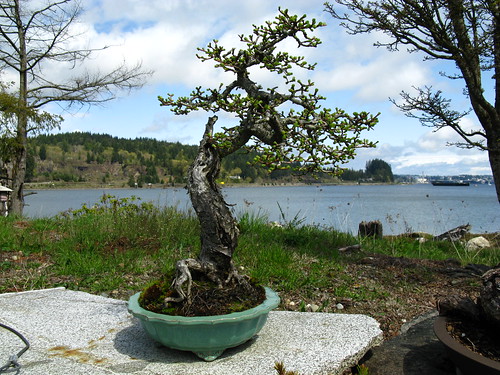
"John Hinds gifted this fine larch to Elandan Gardens. Mr. Hinds acquired about a hundred seedlings from Mussers Nursery in 1974. He trained them for about twenty years and donated a number of them to Elandan in 1994. This fine tree had a large top that I removed by air-layering, giving me two trees. I carved the stub and trained the big remaining branch into the form seen here. Air layering was done in 1997. Carving and wire training was started in 1999."I appreciated the thoughtful placement of container specimens near similar plants in the ground.

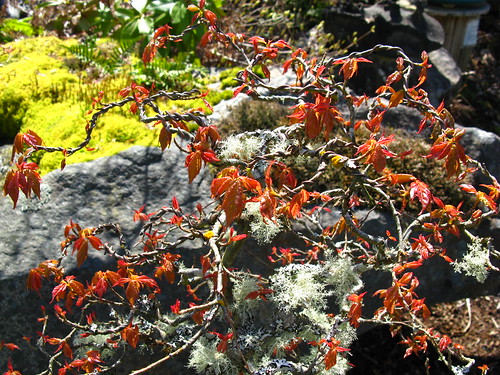
A murky pond in the center of the garden added to the mood...

And served as an appropriate backdrop for many species, like this pond cypress (Taxodium ascendens) from Florida.
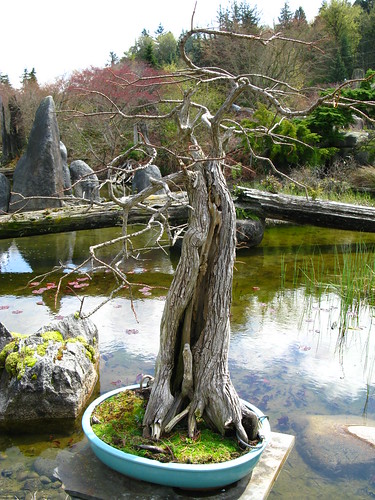
"Year of Origin: 1500. Collected in Florida, this wizened denizen of a tropical swamp has survived all the adversity that southern Florida has to offer. Growing in a swamp is less than ideal. The absence of oxygen, alkaline soil conditions, high-intensity heat, and proliferation of insects all lead to miniaturized growth. My experience indicates that the water immersion is the major dwarfing influence. Pond Cypress is an adaptable tree, surviving in a variety of cold weather climates. Collected in 1998."Every kind of moss seemed to be growing on the garden grounds.

And a lot of it turned up in the bonsai specimens too.

It's hard not to have moss in rainy Washington state. For specimens left out in California, I suppose rocks or Sempervivum would make more sense.
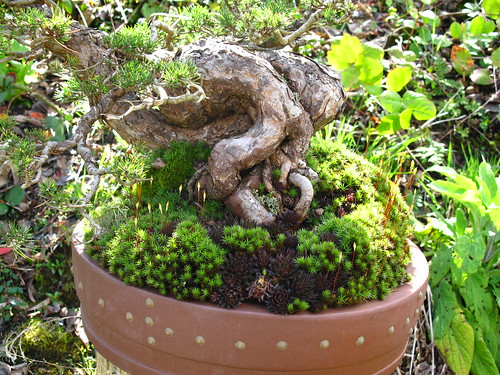

I took this movie to show you the raindrops held like jewels in the fascicles of this larch.
Julie took some great close-ups during our visit. Additionally, she blogged about her own visit here two years ago.

14 comments:
This always amazes me. I love "dated to 1500 AD, is a work in progress" are you talking about a cathederal or a bonsai? We had the opportunity to see the display at the Ntl. Arboretum outside of DC and even the non-gardeners were impressed.
Wow that is just amazing! What a collection! It would be fun to have a bonsai(-: Thanks for sharing these wonderful pictures!!!
CiNdEeS' GaRdEn</a
Bonsai are so incredible! Especially those. Great shots.
Great photos. Bonsai is a little like art topiary to me, not something I could do myself, too manipulative and so forth, but fascinating whenever I see it. That Rocky Mountain Juniper is an amazing specimen, even if a bit ethically dodgy.
Wow! Chuck b. in my neighborhood! I live about 40 minutes from Bremerton and drive by Elanden often. I have been trying to coordinate a visit there with my gardening neighbors. GREAT photos as always and wonderful notes. I am so thrilled that you reporting from my neck of the woods!! Enjoy!!! Bonnie
PS: You should also hit Whitney Gardens in Brinnon while you are here - it's a total Rhody circus!
Hi Chuck, all amazing. Christopher shows the bonsai at the arboretum in Asheville. This makes me want to go even more. The ago on those specimens boggles the mind. Sounds like you had a great trip with your friend.
Frances
A lot of people have a passion that can run amuck and turn into something spectacular. Even in Seattle's climate those tiny dishes will have to be watered on a regular basis. Did you see an irrigation system? That's a lot of work unless you find the zen mode of bonsai.
I saw no irrigation system.
Definitely get your group there, Bonnie. It's a place few seem to to know about, even in Seattle. For bonsai enthusiasts however, it would seem to be a destination worth traveling far to see.
Les: "I love 'dated to 1500 AD, is a work in progress' are you talking about a cathederal or a bonsai?" Lol!
WOW. That's absolutely amazing stuff all around, but I'm still most incredulous about the climbing hydrangea trained into a circle. I NEVER would have thought of climbing hydrangea as potential bonsai material! (Yeah, I gues that's why he has the famous, cool garden, right?)
The bonsai I've seen were in Illinois, Texas and Washington DC - either displayed inside or with some sort of roof or shade over them so they wouldn't fry. It's amazing to see them outside set against 'relatives' growing naturally.
Have to check whether people I know in Seattle have ever driven here.
Thanks, Chuck!
Annie at the Transplantable Rose
Man, I could spend DAYS in that garden! I just love bonsai, and they have some of the most amazing specimens I've ever seen! When I see posts like this it makes me want to take a traveling job so I can visit these cool places too! Maybe someday...
Hey Chuck, great Bonsai post!! loved it! Brian
Wow Chuck, thanks for showing. I didn't know that Seattle has a garden with such an incredible collection of bonsai. I used to visit Seattle quite often (years ago), but only till recently has my interest in bonsai started. I will definitely check out this garden if I visit Seattle again in the future :)
A book was recently published about Dan Robinson, bonsai, and Elandan Gardens, called Gnarly Branches, Ancient Trees. You can get it on Stone Lantern's website. It has gorgeous photos of most of these trees (and many more) and tells the interesting story of Dan's life. Gorgeous book.
Post a Comment